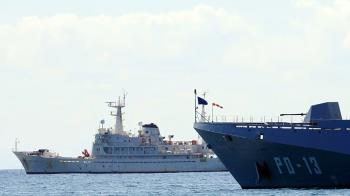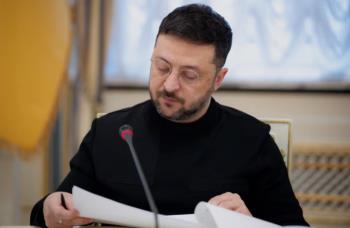Alwaght- Iran inaugurated the last development phase of the world's largest gas field in the Persian Gulf, which French oil and gas major Total quit twice under sanctions.
The Monday inauguration of Phase 11 of South Pars, developed by Iranian experts, put an end to 20 years of waiting and saved the country $800 million in development costs, Minister of Petroleum Javad Owji said.
Owji tagged along President Ebrahim Raeisi during a tour of the site and face-to-face meeting with workers and technicians on board a massive offshore platform, the installation of which has been hailed a national feat.
President Raeisi described the implementation of the project “a technically complex and unique operation”, saying its opening will secure a significant portion of the rights of the nation from common fields.
Phase 11 is the farthest border section of South Pars which Iran shares with Qatar, and every day that is lost costs the country in lost revenue.
The phase will start production at 15 million cubic meters per day and reach an ultimate capacity of 56 million cubic meters of gas plus one million tonnes of ethane, on top of one million tonnes of LPG per year which will generate an annual income of $5 billion, Managing Director of the National Iranian Oil Company (NIOC) Mohsen Khojasteh-Mehr said.
To reach this capacity, 24 wells will be spudded in total. “So far, four wells have been put into operation, and the rest will gradually come on stream,” Khojasteh-Mehr said.
“The development of Phase 11 of Pars South is one of the most strategic and important projects of the Iranian National Oil Company, which came to fruition in the thirteenth administration after 20 years of delay,” he added.
It was in 2005 when NIOC signed a memorandum of understanding for the upstream development of Phase 11 and the construction of a 10 million-tonne LNG production plant. Petronas later joined the $11.2 billion project in a joint venture, 40 percent held by Total, 50 percent by NIOC and 10 percent by Malaysia’s national oil firm.
In 2008, Total and Petronas announced that high development costs in the wake of rising steel prices had forced them to delay a final decision on investment after Iran had repeatedly extended a deadline. Tehran finally dismissed them from the project which was overshadowed by haggling over contract terms.
The project then was awarded to China National Petroleum Corporation (CNPC) in 2010 on a $4 billion financial plan. According to the contract, CNPC should have brought Phase 11 to production within 52 months, but long delays forced Iran to ditch it too in 2012.
After the removal of the Chinese company, Iran decided to carry out the development of the offshore sector independently and earlier than the onshore part because a simultaneous operation in both sections was time-consuming.
An MoU for marine development of the phase was signed then between Petropars and Iran Marine Engineering and Construction Company in May 2013 with the aim of building and operating a jacket, two platforms and two lines of submarine pipeline to transfer gas to the onshore refinery.
Later in August 2013, the contract for the development of the field was awarded to Petropars under a buy-back deal in which the developer is repaid for its investment in oil or gas once production begins, plus a fixed rate of return.
According to the contract, Petropars undertook to construct and install two wellhead platforms (base and deck) and drill 12 wells in each platform, besides building two pipelines of 32 inches each with a length of about 135 km to transfer gas to land as well as facilities for receiving, separating and stabilizing condensates plus condensate storage tanks on land and gas condensate export facilities.
No sooner had eight months passed since the signing of the contract than Petropars withdrew from the project, with then minister of petroleum Bijan Zanganeh declaring that Phase 11 was not the priority at the time and that a decision would be made in due course.
Time passed by and the development of Phase 11 got stuck in further uncertainty, until in 2015 Total stepped in again and offered to work in South Pars.
The French company finally signed a second contract, with a 20-year duration, in 2017 after Iran had concluded the nuclear agreement with the West. It was the operator of the $5.9 billion project with a 50.1% interest alongside the Chinese state-owned oil and gas company CNPC (30%), and Petropars (19.9%), a wholly owned subsidiary of NIOC.
Total again pulled out of the project in late August 2018 after failing to obtain a waiver from reinstated US sanctions on Tehran. The withdrawal was not unexpected but Iran had to pay with further delays for trusting a side which like other French companies was known for breach of contract.
CNPC then replaced Total as the operator, but it also suspended investment in fear of US sanctions in December of the same year, leaving Petropars in total control.
The Iranian company started work from October 2018. It had to build two platforms - which normally takes five years to complete one - to produce 56 million cubic meters of gas per day.
With the inauguration of the new government in August 2021, a new initiative was proposed at NIOC under which one of the platforms at Phase 12 whose production was no longer economical would be removed and installed at Phase 11.
Moving the 3,200-tonne platform required strong logistics, for which Iran brought the Oceanic 5000 crane ship from Russian waters and did the job.
"The steely will of Iranian youths and our experts became proud in this field. The president said: Moving a platform from one phase to another is technically a big task that was accomplished by domestic experts and was done in the shortest possible time.



























